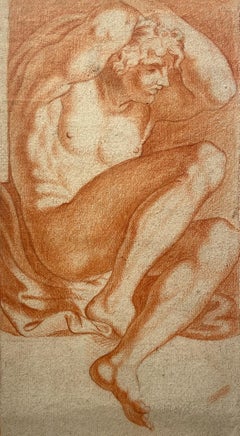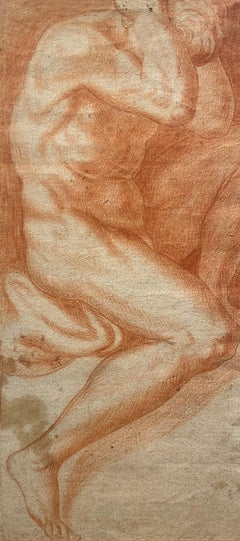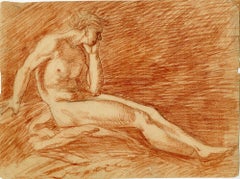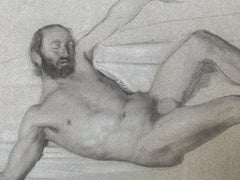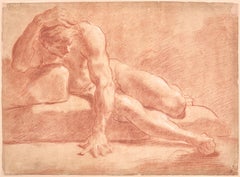18th Century Nude Drawings and Watercolors
to
10
2
7
2
8
4
9
3
Overall Height
to
Overall Width
to
8
12
6
5
5
4
3
3
2
1
1
1
1
1
21
96
1,543
696
15
13
61
98
71
160
162
161
123
77
12
2
1
6
5
4
4
2
Period: 18th Century
The Captive, Study of a Naked Youth, Red Chalk Study, Carracci Gallery
By Annibale Carracci
Located in London, GB
Red chalk on paper
Image size: 5 x 8 1/2 inches (12.75 x 21.5 cm)
Mounted
This 18th century drawing is after the work of the 16th Century Italian artist Annibale Carraci. This figure, along with many more, were painted by Carraci in the Palazzo Farnese in a space now known as the Carracci gallery. The Carracci gallery is considered as one of the most important Renaissance commissions in Rome. This figure, along with five other companions, were known as 'The Captives'. They were designed by the artist to appear trapped in the architectural spaces in the walls and sat around the fresco that featured Perseus and Andromeda.
Similarly to the original drawings, this artist has taken considerable care to sculpt his form with light and shadow, gently blending strokes on the smooth-skinned cheek and distinctly denoting the direction of hair strands.
Annibale Carracci
Annibale Carracci (1560–1609) was the most admired painter of his time and the vital force in the creation of Baroque style. Together with his cousin Ludovico (1555–1619) and his older brother Agostino (1557–1602)—each an outstanding artist—Annibale set out to transform Italian painting. The Carracci rejected the artificiality of Mannerist painting, championing a return to nature coupled with the study of the great northern Italian painters of the Renaissance, especially Correggio, Titian, and Veronese.
During the 1580s, the Carracci were painting the most radical and innovative pictures in Europe. Annibale not only drew from nature, he created a new, broken brushwork to capture movement and the effects of light on form. His Two Children Teasing a Cat marks a new chapter in the history of genre painting. The revolutionary potential of this new kind of painting would be taken up over a decade later by Caravaggio, who must have seen the Carraccis’ work while traveling from Milan to Rome in 1592.
The Carracci saw themselves as heir to a great artistic tradition, and they consciously situated themselves within the history of northern Italian painting. Annibale and Agostino visited Parma and Venice to study the work of Correggio, Titian, Tintoretto, and Veronese. Their altarpieces and secular fresco cycles in Bologna reasserted a northern Italian emphasis on color, light, and the study of nature, but with a new focus on emotive communication. Their success led to Annibale being invited to Rome to work for the powerful Farnese family (1595). Ludovico remained in Bologna to direct the academy they founded. Through the next generation of painters—Francesco Albani, Domenichino, Guido Reni, Giovanni Lanfranco, and Guercino—Bolognese painting became the dominant force in seventeenth-century art.
In Rome, Annibale’s painting was transformed through his first-hand encounter with classical antiquity and the art of Michelangelo and Raphael. Individual scenes of ancient mythology are surrounded by an elaborate illusionistic framework with feigned statues, in front of which sit muscular nude figures seemingly lit from the actual windows (Galleria Farnese ceiling). The corners are opened to painted views of the sky. When unveiled in 1600, the ceiling was instantly acclaimed as the equal of any work in the past. In combining northern Italian naturalism with the idealism of Roman painting, Annibale created the basis of Baroque art. His only challenger in Rome was Caravaggio, whose relation with the past was combative rather than assimilative. Moreover, Caravaggio’s art...
Category
Renaissance 18th Century Nude Drawings and Watercolors
Materials
Chalk, Paper
The Captive, Study of a Naked Man, Red Chalk Study, Carracci Gallery
By Annibale Carracci
Located in London, GB
Red chalk on paper
Image size: 11 x 5 1/2 inches (28 x 14 cm)
Mounted
This 18th century drawing is after the work of the 16th Century Italian artist Annibale Carraci. This figure, along with many more, were painted by Carraci in the Palazzo Farnese in a space now known as the Carracci gallery. The Carracci gallery is considered as one of the most important Renaissance commissions in Rome. This figure, along with five other companions, were known as 'The Captives'. They were designed by the artist to appear trapped in the architectural spaces in the walls and sat around the fresco that featured Perseus and Andromeda.
Annibale Carracci
Annibale Carracci (1560–1609) was the most admired painter of his time and the vital force in the creation of Baroque style. Together with his cousin Ludovico (1555–1619) and his older brother Agostino (1557–1602)—each an outstanding artist—Annibale set out to transform Italian painting. The Carracci rejected the artificiality of Mannerist painting, championing a return to nature coupled with the study of the great northern Italian painters of the Renaissance, especially Correggio, Titian, and Veronese.During the 1580s, the Carracci were painting the most radical and innovative pictures in Europe. Annibale not only drew from nature, he created a new, broken brushwork to capture movement and the effects of light on form. His Two Children Teasing a Cat marks a new chapter in the history of genre painting.
The revolutionary potential of this new kind of painting would be taken up over a decade later by Caravaggio, who must have seen the Carraccis’ work while traveling from Milan to Rome in 1592.The Carracci saw themselves as heir to a great artistic tradition, and they consciously situated themselves within the history of northern Italian painting. Annibale and Agostino visited Parma and Venice to study the work of Correggio, Titian, Tintoretto, and Veronese. Their altarpieces and secular fresco cycles in Bologna reasserted a northern Italian emphasis on color, light, and the study of nature, but with a new focus on emotive communication. Their success led to Annibale being invited to Rome to work for the powerful Farnese family (1595). Ludovico remained in Bologna to direct the academy they founded. Through the next generation of painters—Francesco Albani, Domenichino, Guido Reni, Giovanni Lanfranco, and Guercino—Bolognese painting became the dominant force in seventeenth-century art.
In Rome, Annibale’s painting was transformed through his first-hand encounter with classical antiquity and the art of Michelangelo and Raphael. Individual scenes of ancient mythology are surrounded by an elaborate illusionistic framework with feigned statues, in front of which sit muscular nude figures seemingly lit from the actual windows (Galleria Farnese ceiling). The corners are opened to painted views of the sky. When unveiled in 1600, the ceiling was instantly acclaimed as the equal of any work in the past. In combining northern Italian naturalism with the idealism of Roman painting, Annibale created the basis of Baroque art. His only challenger in Rome was Caravaggio, whose relation with the past was combative rather than assimilative. Moreover, Caravaggio’s art...
Category
Renaissance 18th Century Nude Drawings and Watercolors
Materials
Chalk, Paper
Louis-Félix de La Rue (1730-1777) A Mythological scene, drawing
Located in Paris, FR
Louis-Félix de La Rue (1730-1777)
A Mythological scene
Pen and black ink on paper
Bears an old inscription with the name of the artist on the lower left bo...
Category
Old Masters 18th Century Nude Drawings and Watercolors
Materials
Ink
Life study of a male nude in repose - European School, late 18th Century
Located in Middletown, NY
European School, late 18th century. Red chalk with primo pensiero in graphite on cream laid paper, 8 1/2 x 11 1/2 inches (215 x 293 mm). Scattered light handling wear and multiple s...
Category
Naturalistic 18th Century Nude Drawings and Watercolors
Materials
Pencil, Graphite, Chalk, Laid Paper
18th Century Italian Old Master Drawing Nude Figure Sketches Male & Female
Located in Cirencester, Gloucestershire
Figurative Sketches
Italian School, mid 18th century
circle of Pompeo Batoni (1707-1787)
charcoal and pencil, heightened with white chalk, unframed...
Category
Old Masters 18th Century Nude Drawings and Watercolors
Materials
Charcoal, Pencil, Chalk
Three drawings by François Boucher in a mounting by Jean-Baptiste Glomy
By François Boucher
Located in PARIS, FR
We would like to thank Juliette Parmentier-Courreau of the Custodia Foundation for her welcome and support during the consultation of Glomy’s Journal des Ouvrages.
This spectacularly large "feuille de desseins ajustés" commissioned by François Boucher from Jean-Baptiste Glomy is emblematic of the painter's art and mastery of rocaille. It is also fully representative of the taste of this period in the field of decorative arts. The largest of these three drawings, placed at the bottom of the composition, is particularly interesting: dating from around 1756, it constitutes a modello (apparently unpublished) for the frontispiece of the "Catalogue des tableaux de Monsieur de Julienne"), preserved in the Morgan Library in New York.
1. François Boucher, the master of French rocaille
The extraordinary career of Francois Boucher was unmatched by his contemporaries in versatility, consistency and output. For many, particularly the writers and collectors who led the revival of interest in the French rococo during the last century, his sensuous beauties and plump cupids represent the French eighteenth century at its most typical. His facility with the brush, even when betraying the occasional superficiality of his art, enabled him to master every aspect of painting – history and mythology, portraiture, landscape, ordinary life and, as part of larger compositions, even still life. He had been trained as an engraver, and the skills of a draftsman, which he imbued in the studio of Jean-Francois Cars (1661 – 1738), stood him in good stead throughout his career; his delightful drawings are one of the most sought-after aspects of his oeuvre.
As a student of Francois Lemoyne (1688 - 1737), he mastered the art of composition. The four years he spent in Italy, from 1727-1731, educated him in the works of the masters, classics and history, that his modest upbringing had denied him.
On his return to Paris in 1734, he gained full membership of the Royal Academy of Painting and Sculpture with his splendid Rinaldo and Armida (Paris, Musée du Louvre). Although, throughout his career, he occasionally painted subjects taken from the Bible, and would always have considered himself first as a history painter, his own repertoire of heroines, seductresses, flirtatious peasant girls and erotic beauties was better suited to a lighter, more decorative subject matter. His mastery of technique and composition enabled him to move from large scale tapestry...
Category
Old Masters 18th Century Nude Drawings and Watercolors
Materials
Chalk, Ink
Original Male Nude Study Drawing By Ziesenis
Located in San Francisco, CA
C. Early 18th Century
Original early 18th C. male nude study graphite drawing by Johann Ziesenis (1716-1776)
Johann Georg Ziesenis was a German – Danish portrait painter.
His father Johan Jürgen Ziesenis was a painter from Hanover who had been granted Danish citizenship in Copenhagen in 1709 and whose works included a 1739 Baptism of Christ for Copenhagen's garrison church. After drawing lessons from his father, Johann lived in Düsseldorf, where he gained further training and painted several portraits of the royal family. In 1764 he became court painter at Hanover and in 1766 he was granted 400 kroner by the Danish king "for travel and other expenses". In 1768 he was in the Netherlands, where he produced portraits of William V...
Category
18th Century Nude Drawings and Watercolors
Materials
Pencil, Paper
Louis-Félix de La Rue (1730-1777) A Mythological scene, drawing
Located in Paris, FR
Louis-Félix de La Rue (1730-1777)
A biblical or mythological episode
Signed and dated lower right (under the mount, see photos of the drawing out of frame)
...
Category
Old Masters 18th Century Nude Drawings and Watercolors
Materials
Ink
French Neo classical school, Allegory of Time, original drawing
Located in Paris, FR
Neo classical school, France, end of the 18th Century
Allegory of Time,
Pen and black ink on paper, gray ink wash
30.5 x 19 cm
irregularly shaped
In g...
Category
Old Masters 18th Century Nude Drawings and Watercolors
Materials
India Ink
Reclining Youth, 18th Century Nude Graphite on Paper
Located in London, GB
French School
18th Century
Reclining Youth
Graphite and charcoal on paper
Image size: 15 x 23 inches (38 x 58.5 cm)
Wash line mount and gilt frame
Painting in eighteenth-century Fra...
Category
Old Masters 18th Century Nude Drawings and Watercolors
Materials
Graphite, Charcoal
Study in the Antique Style, a neoclassical drawing by Augustin Pajou
Located in PARIS, FR
In this lively and fresh drawing, probably taken from one of the artist's notebooks, Pajou presents us with a composition freely inspired by antiquity, as a souvenir of a visit to th...
Category
Old Masters 18th Century Nude Drawings and Watercolors
Materials
Ink
Study of Nude Man, a red chalk study by Ubaldo Gandolfi (1728 - 1781)
Located in PARIS, FR
We would like to thank Marco Riccòmini for his help in preparing this note and in particular for pointing out the existence of the drawing in the Musei Civici of Reggio Emilia.
The ...
Category
Old Masters 18th Century Nude Drawings and Watercolors
Materials
Chalk
Related Items
Nudo maschile nella posa di un satiro dormiente. XIX secolo
Located in Firenze, IT
Disegno del nudo maschile.
Dal 19 ° secolo
Disegno su carta leggermente colorata.
In buone condizioni.
Il disegno rappresenta un uomo sdraiato, che si abbandona al sonno.
In una posa...
Category
Academic 18th Century Nude Drawings and Watercolors
Materials
Paper, Carbon Pencil
Free Shipping
H 13.39 in W 18.51 in D 0.04 in
MB 824 (Double-Sided Figure Drawing of Handsome Nude Men by Mark Beard)
By Mark Beard
Located in Hudson, NY
Figurative, academic style life drawing of male nude with charcoal and graphite by Mark Beard, "MB 824"
graphite, Conte crayon and charcoal on Arches paper
30.5 x 21 inches unframed
...
Category
Contemporary 18th Century Nude Drawings and Watercolors
Materials
Charcoal, Conté, Graphite, Archival Paper
MB 827 (Contemporary Life Drawing of Two Nude Males by Mark Beard)
By Mark Beard
Located in Hudson, NY
Academic life drawing of two nude males with charcoal and graphite by Mark Beard, "MB 827"
graphite, Conte crayon and charcoal on Arches paper
29.75 x 21.75 inches unframed
Signed, l...
Category
Contemporary 18th Century Nude Drawings and Watercolors
Materials
Charcoal, Archival Paper, Graphite, Conté
H 29.75 in W 21.75 in
Preparatory anatomical study for the figure of a man with hands on his face.
Located in Firenze, IT
Preparatory anatomical study for the figure of a man with hands on his face.
Drawing of a medium-sized male nude.
From the 19th century
Drawing on slightly greyish colored paper.
In ...
Category
Academic 18th Century Nude Drawings and Watercolors
Materials
Gesso, Paper, Charcoal, Carbon Pencil
Free Shipping
H 17.72 in W 13.39 in
MB 702 (Contemporary Life Drawing of Male Nude by Mark Beard)
By Mark Beard
Located in Hudson, NY
MB 702 (Contemporary Life Drawing of Male Nude by Mark Beard)
graphite, Conte crayon and charcoal on Arches paper
30 x 19 inches unframed
Con...
Category
Contemporary 18th Century Nude Drawings and Watercolors
Materials
Conté, Charcoal, Archival Paper, Graphite
MB 085A (Contemporary Life Drawing of Nude Male by Mark Beard)
By Mark Beard
Located in Hudson, NY
Academic life drawing of male nude with charcoal and graphite by Mark Beard, "MB 085A"
graphite, Conte crayon and charcoal on Arches paper
30 x 18.5 inches unframed
Signed, lower rig...
Category
Contemporary 18th Century Nude Drawings and Watercolors
Materials
Charcoal, Archival Paper, Graphite, Conté
Study, preparatory work for “La Princesse”, watercolor and pencil on paper
Located in PARIS, FR
Raphael DELORME (1886-1962)
Study, preparatory work for “La Princesse”
Watercolor and pencil on paper
Annotated “La Princesse”
30,5 x 22,5 cm
Small folds and small stains
Born in 18...
Category
Art Deco 18th Century Nude Drawings and Watercolors
Materials
Watercolor, Pencil
DRAWING OF SAM I
By Amanda Watt
Located in Aventura, FL
Original pencil, chalk and crayon drawing on paper. Hand signed and dated on front by the artist. Framed. Artwork is in excellent condition. Certificate of authenticity included. A...
Category
Contemporary 18th Century Nude Drawings and Watercolors
Materials
Chalk, Pencil, Crayon, Paper
MB 018 (Figurative Life Drawing of Handsome Male Nude by Mark Beard)
By Mark Beard
Located in Hudson, NY
Academic life drawing of male nude with charcoal and graphite by Mark Beard, "MB 018"
graphite, Conte crayon and charcoal on Arches paper
30 x 19 inches unframed
Signed, lower right
...
Category
Contemporary 18th Century Nude Drawings and Watercolors
Materials
Charcoal, Archival Paper, Graphite, Conté
MB 001 (Modern, Academic Style Figurative Life Drawing of Muscular Male Nude )
By Mark Beard
Located in Hudson, NY
Figurative male nude drawing on Arches paper by Mark Beard
graphite, conte crayon and charcoal on Arches paper
22 x 15 inches unframed
Contemporary figurative life study drawing of ...
Category
Modern 18th Century Nude Drawings and Watercolors
Materials
Conté, Graphite
Study, preparatory work for “La Princesse”, watercolor and pencil on paper
Located in PARIS, FR
Raphael DELORME (1886-1962)
Study, preparatory work for “La Princesse”
Watercolor and pencil on paper
Annotated “La Princesse”
30,5 x 22,5 cm
Small folds and small stains
Born in 18...
Category
Art Deco 18th Century Nude Drawings and Watercolors
Materials
Pencil, Watercolor
MB 005 (Modern, Traditional Style Figurative Life Drawing of Muscular Male Nude)
By Mark Beard
Located in Hudson, NY
Figurative nude drawing on Arches paper
graphite, conte crayon and charcoal on Arches paper
22 x 15 inches unframed
Contemporary figurative life study drawing of a reclining male nu...
Category
Modern 18th Century Nude Drawings and Watercolors
Materials
Conté, Graphite
Previously Available Items
French School 18th century, The Judgement of Paris, original drawing
Located in Paris, FR
French School 18th century,
The Judgement of Paris,
Pen and back ink and black ink wash on paper
14.5 x 17 cm
Framed : 28 x 31 cm
The particularly fine execution of this 18th century drawing is reminiscent of the style of the great draughtsmen of the period, but at this stage there is no sure way of attributing it.
The theme of the work is obviously well known, the Judgement of Paris was particularly popular, and we remember its treatment by Antoine Watteau, but it crosses the whole history of art.
The Judgement of Paris is a story from Greek mythology, which was one of the events that led up to the Trojan War and in later versions of the story to the foundation of Rome :
Eris, the goddess of discord, was not invited to the wedding of Peleus and Thetis. In revenge, Eris brought a golden apple, inscribed, "To the fairest one," which she threw into the wedding. Three goddesses...
Category
Old Masters 18th Century Nude Drawings and Watercolors
Materials
Ink
Study of Nude Man, a red chalk study by Ubaldo Gandolfi (1728 - 1781)
Located in PARIS, FR
We would like to thank Marco Riccòmini for his help in preparing this note and in particular for pointing out the existence of the drawing in the Musei Civici of Reggio Emilia.
The ...
Category
Old Masters 18th Century Nude Drawings and Watercolors
Materials
Chalk
After Michelangelo - 18th Century Sanguine, Detail from the Creation of Adam
Located in Corsham, GB
A sanguine study of a male torso in the manner of Old Master drawings. The study is possibly after a detail from Michelangelo's (1475-1564) 'The Creation of Adam' (c.1508-1512) in th...
Category
18th Century Nude Drawings and Watercolors
Materials
Chalk
Louis-Félix de La Rue (1730-1777) Venus at Vulcan's Forge, drawing
Located in Paris, FR
Louis-Félix de La Rue (1730-1777)
Venus at Vulcan's Forge
Brown ink on paper
19.5 x 32 cm
In good condition, only a small spot on the lower right see phot...
Category
Old Masters 18th Century Nude Drawings and Watercolors
Materials
Ink
Pietro Antonio Novelli, study from a work a Marteen De Vos, 18th, ink/watercolor
Located in Florence, IT
This drawing, ink and watercolors on light blue paper, is a study based on a engraving by the flemish artist Maarten De Vos. It belongs to Pietro Antonio Novelli, that was an Italian painter and engraver.
Novelli trained with the Venetian painter Jacopo Amigoni...
Category
Other Art Style 18th Century Nude Drawings and Watercolors
Materials
Paper, Ink, Watercolor
Sepia Drawing of a Male Nude Holding an Anvil, Attributed G. Bazzini 1690-1769
Located in Hallowell, ME
Bearing signature and attributed to Bazinni, red chalk on laid paper, net image is approximately 19" x 13 3/4"
Category
Old Masters 18th Century Nude Drawings and Watercolors
Materials
Chalk
Antoine Borel (1743-1810), A sleeping Nymph and a Satyr, watercolor
By Antoine Borel
Located in Paris, FR
Antoine Borel (1743-1810)
A sleeping Nymph and a Satyr
Signed lower left
Watercolor on paper
13 x 16.5 cm
Stains and foxings, yellowed (as visible in the pictures)
Framed : 25 x 28 ...
Category
Old Masters 18th Century Nude Drawings and Watercolors
Materials
Watercolor
Recently Viewed
View AllMore Ways To Browse
Jules Emile Zingg
Jain Wallis On Sale
Rosemarie Schulz On Sale
Warren B. Davis On Sale
Joaquin Hernandez
Gino Starace
Dmitrii Drugakov On Sale
Framed Silver Butterflies
Antique Painting Boy
Golden Coins
Equestrian Portrait Paintings
European Landscape Painted Screen
Tree Of Life Folk Art
Paris Sellers
St Johns Dresses
Mars Sculpture
Cute Japanese
Erotic Animal
